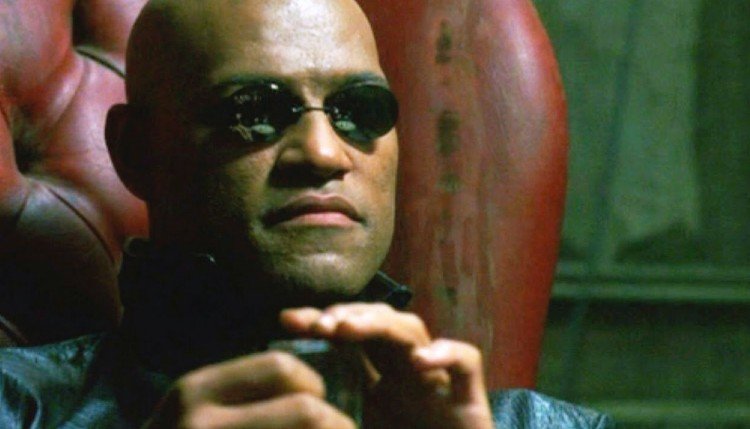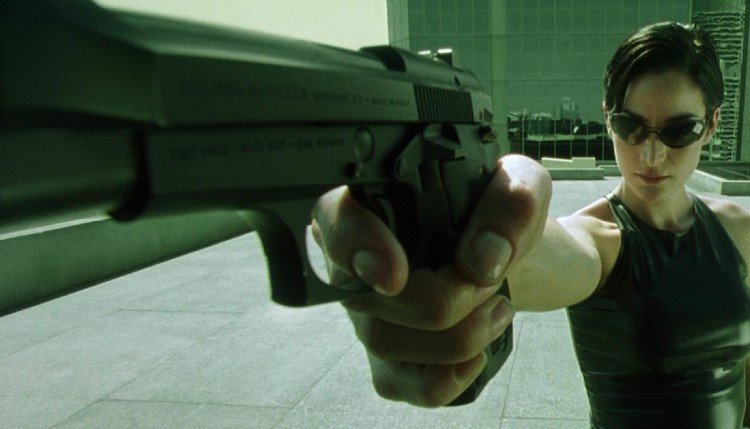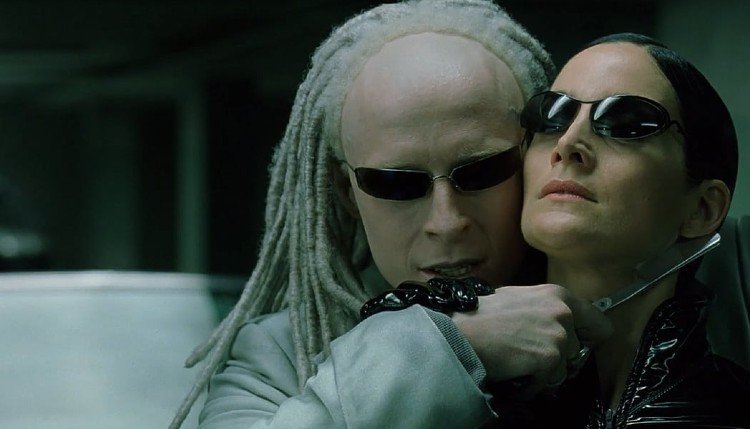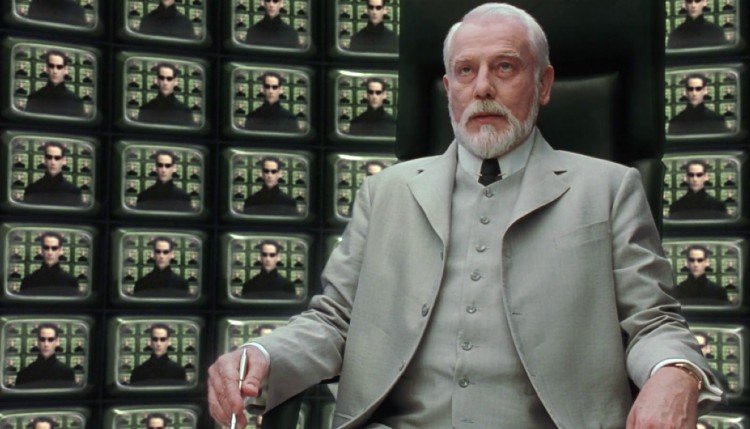Franchise Rewind: The Matrix (1999) The Matrix Reloaded (2003)
The Matrix, 1999 (Keanu Reeves) Warner Bros.
The Matrix Reloaded, 2003 (Laurence Fishburne) Warner Bros.
“There is no spoon.”
How much of The Matrix makes sense and how much of The Matrix doesn’t make sense? Let’s try to break it down from the perspective of a computer (at least what I understand about computers). If you want to be stupid about it, computers speak languages, and all of those languages are derived from different combinations of “ones” and “zeroes.” This is what’s known as binary language—”one” meaning “on” and “zero” meaning “off.”
The word, binary, is defined as “relating to, composed of, or involving two things.” “On” and “off” can also mean “yes” and “no” or “true” and “false.” That’s all the computer understands. That’s all the computer can understand. By its nature, anything that a computer can compose would be simulacrum without regard for taste, feel, or clarity, and any hope for a relationship between the computer (the “hard drive,” specifically) and the human brain would have to be dependent on the computer’s ability to fool the human brain by making a world so real, we wouldn’t be able to tell the difference.
The only way this can work is if you have no established criteria from which to compare a conceivable utopia from a realistic dystopia. Therein lies the fundamental problem with the Matrix franchise. Keanu Reeves plays computer programmer Thomas Anderson, known in his hacker circles as “Neo.” Neo discovers repeated references to a “Matrix,” and before he knows it, he is captured and interrogated by “Agent Smith” (in reality, a construct of the Matrix) played memorably by Hugo Weaving (easily the franchise’s greatest asset).

Smith wants to use Neo to get to what he considers to be the real power, Morpheus (Laurence Fishburne), as well as his associate, Trinity (Carrie-Anne Moss). The first few minutes of The Matrix are incredible with 360 degree views of balletic fighting sequences; hands, fists, and legs frozen in time for seconds, as well as gravity-defying walks on walls and spiraling kicks. Other than the initial credit sequence, you wouldn’t know the movie had anything to do with computers.
You would just think it was a particularly snazzy approach to martial combat and gunplay. Morpheus and Trinity rescue Neo, sit him down, and unravel some dirty truth on him. It turns out his whole life (everyone’s life) is a lie. In one of the last ever iconic scenes in cinema, Morpheus shows Neo two pills, one blue and one red (again, two choices—binary). If Neo takes the red pill, he goes further down the “rabbit hole.” If he takes the blue pill, it’s back to business as usual. Neo is adventurous.
He takes the red pill. I don’t believe the pill itself has any powers. It’s really more of a symbol than anything else. I do believe that Neo chooses “reality” (whatever that is) and thus when he pops the pill, his universe changes almost immediately. The fears are very specific to readers of William Gibson, Philip K. Dick, Roger Zelazny, Harlan Ellison among many, many others in which we don’t necessarily live a life of our own construction.
Instead, we live at the pleasure of machines that use our bodies (our minds specifically) as fuel for their metallic empires. We would all be “God’s creatures” if God were a machine. Humans are confined to pods like constructed placental sacks with cables like umbilical supports connected to their bodies. Our natural electrical impulses are stolen from us by the machines to power themselves while feeding us computer-generated illusions of our lives.

Morpheus pilots the Nebuchadnezzar, a ship that travels inside the real world, which appears to be a dystopic environment (called “Zion”), beset by machine-controlled Sentinel ships. Everything up to that point in the movie makes sense. It’s only when we go outside that logic and start embracing “chosen ones” and “oracles” that The Matrix gets silly in a big hurry. Once he is liberated from his prison, Neo visits the so-called Oracle (Gloria Foster), and this is where the movie starts to lose me. I know the computers construct the fantasy, so I wonder how an Oracle could exist within that fantasy without being terminated.
“Cypher” (Joe Pantoliano) betrays the group to “Agent Smith” who wipes out most of Morpheus’ team within the Matrix. Smith captures Morpheus and demands the access codes for the central computer in Zion, and Neo and Trinity must rescue him. The Matrix was (you’ll forgive the word) destined to be a very simple story. You’ll recognize beats from other (better) stories and movies, and as long as you don’t take the whole thing too seriously, as well as recognize that there isn’t a single original component to the story, The Matrix should be a rewarding experience.
“Choice is an illusion created between those with power and those without.”
Sequels come about for different reasons. Sometimes (very rarely) it’s the continuation of a story. Most times it’s a different story with characters from the previous movie dropped in to chart their own evolution. Of course, we know the real reason we have sequels. It was something I briefly considered in my Rocky II review. In theory, it takes less time to greenlight, requires a smaller investment to begin production, has established characters and mythology with which the audience is already familiar, and drives up the studio’s stock price. It’s money in the bank!

It’s also very rare that a sequel will outperform its predecessor. The Matrix Reloaded is one of those exceptions. The movie made over $700 million at the box office (at a little over twice the original movie’s budget, mind you), compared with the original’s gross of $460 million, making it the highest-grossing R-rated (a soft R-rating, to be sure) film of all time until 2016’s Deadpool. In fact a few cuts for some of the blood could easily give both movies a PG-13 rating. Even the bizarre “orgy” scene is tame. The movie’s violence is cartoonish and over-the-top, particularly in a scene where Neo fights not one, not two, but one-hundred “Agent Smiths.”
What The Matrix Reloaded lacks in story, it more than makes up for with bizarre and ridiculous set-pieces designed, it would appear, to impress the audience with how much money could possibly be spent on something so meaningless as a Matrix sequel. The audience may have been bamboozled by this sequel, but at least some of them stayed away when Revolutions was released. This is a classic example of what the filmmakers assumed the audience wanted from a Matrix sequel. The Matrix Reloaded introduces a host of new characters in an effort to expand the empire of Zion.
Gina Torres and Nona Gaye are in the movie for a combined five minutes, and they really don’t look like they want to be there, which is always fun. We assumed with the first movie that Morpheus (Laurence Fishburne) was the leader of this convenient cult, but as it happens, there is an hierarchy and a political structure. The more important leaders (Cornel West and Anthony Zerbe among them) sit on a Jedi-like council and issue orders like politicians, while there are Commanders such as Morpheus and his girlfriend-stealing rival, Lock (Harry Lennix).
The girlfriend in question is Niobe (Jada Pinkett-Smith), so at least there is some stupid drama in-between all the endless chase-and-fight and fight-and-chase scenes. If any of this sounds tedious, it’s because it is tedious. Neo meets with the Oracle (Gloria Foster) who tells him he must find somebody called the Keymaker (where’s the Gatekeeper?) so that he can lead them to the “source” of the Matrix. Okay, now the Matrix has a source? It does go right into the movie’s best scene so I won’t give this twist too much of a hard time, but I will say that the script is just one door leading to another while going down one hallway after another.

In fact, there’s a scene in the movie that plays out exactly this way. “Agent Smith” now has the ability to assimilate other characters (including those outside the Matrix in Zion) which makes him unstoppable. Neo and the gang get into skirmishes with a set of twins that look like Johnny and Edgar Winter with dreadlocks, which goes into a high-speed chase on the freeway that culminates in an extravagant truck collision. The Keymaker sends Neo to the “Source,” which is a room filled with televisions and a couple of upholstered armchairs.
Sitting in one of the chairs is The Architect (Helmut Bakaitis). He informs Neo that he was constructed by the Matrix to rebuild Zion once it is destroyed. He’s done it five times before (according to The Architect) and he is destined to do it again. I wonder if this is actually true. It seems like a load of B.S. designed to control and confuse Neo. Or is it possible the machines surmise humans need rebellion and resistance once in a while to make them feel they can control their own lives.
If so, it’s an incredible missed opportunity. Instead, the Wachowskis want to play it slick and give us another traitor, this time in Bane (Ian Bliss). I wish these movies were made with fewer visual effects. I find them distracting on this scale. A sequel wasn’t even necessary, The Matrix Reloaded is an earth-shattering disappointment, and the use of Rage Against The Machine’s “Calm Like a Bomb” (one of my favorite songs) in the end credits was embarrassing. Hey, Wachowskis? You are the machine!

